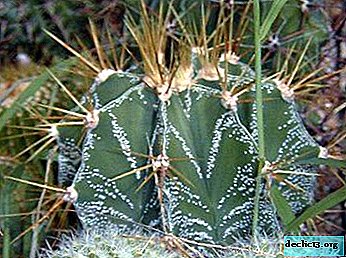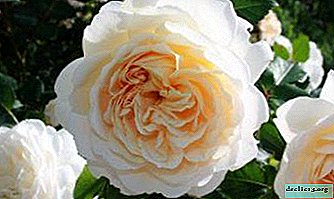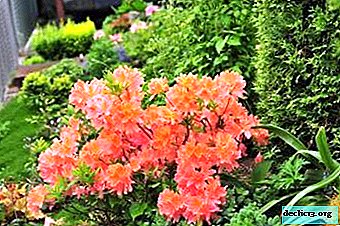Unusual indoor plant resembling a star - Astrophytum decorated

Astrophytum Ornatum is the largest of the genus Astrophytum. Despite the slow growth in vivo, it can grow up to 2 meters long.
At a young age, it has a round shape, as it grows older it is drawn into an ellipsoid.
This plant is unpretentious in care and can become a real decoration of any home, which contributes to its popularity.
In the article, we consider the basic rules for caring for this plant, and also find out what diseases and pests Astrophitum Ornatum can comprehend.
Astrophytum ornatum: a botanical description
Astrophytum Ornatum (Astrophytum ornatum) is a slowly growing, stable representative of the Cactus family. Also this houseplant is called Astrophytum Decorated. The name of the genus comes from Greek words and translates as a star-plant.
Homeland Astrophytum Ornatum - hot areas of the southern United States and Mexico. Is the very first representative of the Cactus family of its kind. Dr. Thomas Coulte found him near the Barranca de Venados Valley.
Astrophytum Ornatum is a beautiful and unusual cactus with a spherical gray-green stem, which stretches over time. The surface of the stem is covered with silver dots. The thorns are stiff and straight. Blossoms Astrophytum Ornatum with light yellow flowers. The fruits are green, with brown seeds inside.
Basic care rules
 Temperature. Astrophytum Ornatum tolerates summer temperatures well at + 22- + 28 ° C. In winter, the temperature is needed in the range from + 8 to +9.
Temperature. Astrophytum Ornatum tolerates summer temperatures well at + 22- + 28 ° C. In winter, the temperature is needed in the range from + 8 to +9.- Watering. Ornatum Astrophytum requires moderate watering in the summer. In winter, they completely stop watering it. Astrophytum Ornatum is very sensitive to waterlogging.
- Shine. Astrophytum Ornatum loves light very much. It requires bright intense lighting, it is possible with direct sunlight, but it is better if it is scattered light.
- Soil and pot. The pot is better to be ceramic. It should also have a large number of drainage holes. Drain is needed at the bottom of the pot. The soil should be very slightly acidic, closer to neutral. A land mixture of coarse-grained substrate, peat chips, clay soil, gravel and sand is suitable.
Attention! Astrophytums do not tolerate too acidic soil.
- Pruning. The pruning that forms the plant is not performed at the Astrophytum Ornatum. Cut the plant only in case of decay. In this case, you need:
- Trim all rot to a completely clean cut with a sharp knife.
- And then treat with a disinfectant solution, for example, alcohol.
- After that, stop watering the cactus until it is fully restored.
- Top dressing. From mid-spring to mid-summer, every three weeks Astrophytum Ornatum is fed with fertilizers. To do this, use special fertilizers for cacti.
- Transfer. Young specimens of Astrophytum Ornatum are transplanted annually for the first 4 years. The transplant is made in the spring.
- For transplantation, a ceramic container is selected according to the size of the root system. It should also have a large number of drainage holes.
- A drainage layer of gravel about 2-3 cm high is poured at the bottom of the pot.
- The plant is being transferred from an old pot to a new one. At the same time, com with roots do not destroy.
Adults Astrophytomas are not recommended for transplantation.
- Wintering. In winter, it needs additional lighting and a temperature of 8-9 degrees.
Breeding
 Astrophytum Ortnatum reproduces only by seed. Seed germination decreases over time, so it is not recommended to use seeds older than 2 years. Seeds are sown at the beginning of spring. For sowing, use wide shallow plates. For seedlings using universal peat soil, a mixture of sand and crushed charcoal in the proportions of 1: 0.5: 0.25.
Astrophytum Ortnatum reproduces only by seed. Seed germination decreases over time, so it is not recommended to use seeds older than 2 years. Seeds are sown at the beginning of spring. For sowing, use wide shallow plates. For seedlings using universal peat soil, a mixture of sand and crushed charcoal in the proportions of 1: 0.5: 0.25.
- Before sowing, you can soak the seeds in a weak solution of potassium permanganate for 10 minutes. The solution should be at room temperature.
- It is necessary to dry the seeds in air.
- When planting, the seed material does not burrow into the ground, but simply is laid on the surface of the soil.
- Then you need to slightly moisten from the spray gun and cover with a film. You can use glass instead of film. It turns out a mini greenhouse.
In order for shoots to appear in 1-2 weeks, it is enough to maintain a temperature of 25-27 degrees, and air the crops 2-3 times a day. In order not to ruin the seedlings, water very carefully and take care of additional lighting. Gradually, the cover of the film can be removed. When the seedlings begin to interfere with each other, they can be planted in separate small pots.
Bloom
Blossoms Astrophytum Ornatum with light yellow flowers up to 10 centimeters in diameter. This type of plant blooms when it becomes an adult, somewhere in the range between 9-15 years. The flowering of the Astrophytum Ornatum occurs from mid-spring to early autumn.
What to do if it does not bloom?
If there are no flowers, then it is possible:
- not enough light;
- temperature or water conditions not observed;
- the plant is still too young.
Placed in a well-lit place, a young plant will begin to bloom from April to September.if it is properly watered, and also observe the temperature regime.
Diseases and Pests
 The main pests are:
The main pests are:
- scale insects;
- mealybug;
- root worm.
It’s easy enough to see the scale insects and mealybugs, but rootworms can be identified by white bloom on the root system and the oppressed appearance of the plant. It stops growing. Soap solution will help get rid of pests. If the solution still does not help, use an insecticide.
Another astrophytum disease is decay. It arises from excessive watering.
Similar views
Similar colors include:
- Astrophytum Kabuto.
- Astrophytum coahuilence.
- Astrophytum is stellate.
- Astrophytum speckled.
- Astrophytum Capricorn.
Photos and detailed descriptions of the types of astrophytum you will find in this material.
Thus, Astrophytum Ornatum is a unique cactus, which, despite its slow growth, is the largest among Astrophytum. His unpretentiousness in care will appeal to both those who are just starting to try their hand at gardening, and experienced gardeners.

 Temperature. Astrophytum Ornatum tolerates summer temperatures well at + 22- + 28 ° C. In winter, the temperature is needed in the range from + 8 to +9.
Temperature. Astrophytum Ornatum tolerates summer temperatures well at + 22- + 28 ° C. In winter, the temperature is needed in the range from + 8 to +9.















